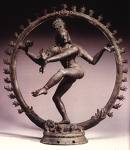|
Nata is a
martial art form in which finger movements, taken from an ancient Indian
dance, are used alongside yogic movements.Although little is known about the
art today, it is quite likely that it included finger - and wristlocking
manoevresand weapons disarms based on joint locks and pain-compliance
techniques. |
 |
|
The
practitionersof ancient Indian dance possessed a good understanding of the
physiological make-up of the joints, in particular the arms, hands, and
fingers as these types of movements were stressed in ancient Indian dance.
It is likely that the arts were included in other ancient Indian martiak
arts such as weapon forms and grappling sports. In the 3rd century BCE, the
autho Patanjali wrote the Yoga Sutras, the ancient foundational text of
Yoga.
These yogic elements, as well as finger movements in the Nata dances were
incorporated into various martial arts. Futhermore, there are several
references in early historical Buddhist texts such as the Lotus Sutra,
written in the 1st centuryCE, which refer to Indian martial arts of boxing
and, in particular, techniques of joint locking, fist strikes, grapples and
throws.
Although the
subject of speculation among historians, it is possible that these elements
describe the evolution of hand movements and locking techniques from the
early Nata dances into later martial-art forms.
The depiction of
Shiva, one of the principle deities of Hinduism, as Nataraja ("Lord Of The
Dance") is the inspiration for Nata. |













